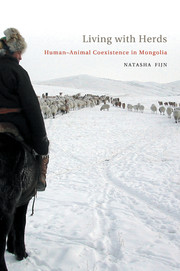Book contents
- Frontmatter
- Contents
- Lists of Plates, Figures, Maps, Tables, and Online Video Segments
- Glossary
- Acknowledgments
- LIVING WITH HERDS
- PART ONE CROSSING BOUNDARIES
- PART TWO THE SOCIAL HERD
- PART THREE LIVING WITH HERDS
- 7 IN THE LAND OF THE HORSE
- 8 THE CYCLE OF LIFE: BIRTH TO DEATH, SPRING TO WINTER
- 9 THE DOMESTIC AND THE WILD
- 10 THE SACRED ANIMAL
- CONCLUSION: CO-DOMESTIC LIVES
- Appendix
- References
- Index
- Plate section
10 - THE SACRED ANIMAL
from PART THREE - LIVING WITH HERDS
Published online by Cambridge University Press: 03 May 2011
- Frontmatter
- Contents
- Lists of Plates, Figures, Maps, Tables, and Online Video Segments
- Glossary
- Acknowledgments
- LIVING WITH HERDS
- PART ONE CROSSING BOUNDARIES
- PART TWO THE SOCIAL HERD
- PART THREE LIVING WITH HERDS
- 7 IN THE LAND OF THE HORSE
- 8 THE CYCLE OF LIFE: BIRTH TO DEATH, SPRING TO WINTER
- 9 THE DOMESTIC AND THE WILD
- 10 THE SACRED ANIMAL
- CONCLUSION: CO-DOMESTIC LIVES
- Appendix
- References
- Index
- Plate section
Summary
INTRODUCTION
A pictorial depiction of Maliin Banzuragch, a Mongolian Buddhist god and protector of the five kinds of co-domestic animal (tavan khoshuu mal), is situated next to the shrine at the rear of Dogsomjav's ger (see Figure 10.1). The top centre of the picture depicts a god riding a horse-like beast into the heavens. Key elements of fire and water are central components of the drawing. Each of the five kinds of herd animal flanks the central gods: a female horse, cow, sheep, goat, and camel, each nursing her own young. Below, and to one side, a figure is revealed stealing livestock and on the opposite side a wolf has been slain by arrows. This cloth thangkar helps protect Dogsomjav's precious herd animals from harm.
The practices I detail within this chapter offer a means of understanding the underlying attitudes and relationships that Mongolian herders have with the animals they herd. I use the term “spirituality” with caution, as I intend to convey the concept of beings containing an “indeterminate energy” (Humphrey with Onon, 1996) or heightened power. A crucial thought that nagged me throughout my fieldwork was this: How can these herders kill and eat the animals that they have known since birth, to whom they have given individual names, and who are referred to as individual personalities with specific characteristics?
- Type
- Chapter
- Information
- Living with HerdsHuman-Animal Coexistence in Mongolia, pp. 221 - 240Publisher: Cambridge University PressPrint publication year: 2011



